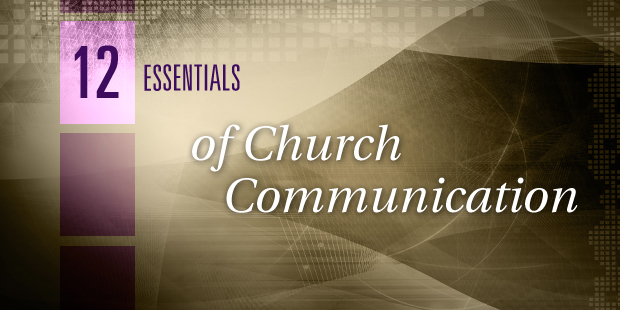Inside the church (internally), stage announcements are a constant battle. The people programming services, who are in charge of the flow of services, are constantly asking:
- Do we really have to do announcements?
- When can we do announcements so it doesn’t mess up the flow of worship?
- Is it worth it since people aren’t even listening to the announcements?
Then you have every single ministry leader fighting for stage time. They want their ministry, event or serving opportunity presented from the stage. So now you have the conflict of everybody wanting stage time, and the people who are directing the flow of the service forced to decide what will be communicated and when it will be communicated.
With all the chaos and discord, I’ve often heard the frustrated refrain behind the scenes at churches: We’re not going to do announcements anymore. Yet they all continue to do announcements because it is a great opportunity to speak to your congregation as they are sitting in a seat right before you and you have their attention.
Make no mistake, announcements are extremely hard.
As a communications professional and former communications pastor, I know firsthand the challenges posed by announcements. Yet when I sit in church as a member and somebody says the word announcements (“I have a couple announcements for you this morning…”), my mind automatically checks out. It always leads me to wonder:
- How can we better maximize this stage time when we’re announcing what is going on inside our church?
- What can we possibly do to take full advantage of having the attention of all these people?
In answer to those questions, here are six ways you can capture people’s attention and maximize stage announcements on a Sunday morning.
#1. Follow the 80% rule.
When you’re deciding what you’re going to communicate from stage, unless it’s an abnormal situation, you want to ask yourself: Does this impact 80% of the audience sitting inside our worship center? If the event, ministry, serving opportunity or message does not impact 80% of your audience, then you do not want to dedicate stage time to it.
Remember you only have an hour or so of people’s attention a week. You don’t want to waste a single minute. If a message doesn’t impact 80%, as a communication leader you have to politely say “no” and give them other ways to communicate that message – through the e-newsletter, social media, or the website events page. You have to protect the stage with only messages pertinent to 80% or more of the entire audience.
#2. Lead with “the why”.
I see this all the time with church leaders. They stand on the stage and start rambling about the what, when and how of an event, ministry or message. They throw out words, dates and times, and people turn their ears off because it doesn’t capture them. I say this over and over on this blog because it is so important – you have to lead with why. Capture their heart about the event, serving opportunity or ministry, and then subtly and quickly give them the what, when and how.
You can even give them the what, when and how on a media slide projected behind the stage presenter. That way you don’t even have to state the information and people can still absorb it. Then you can really zone in on the why. The why is also the perfect opportunity for you to tie a life-change story to an event, ministry or serving opportunity. If it’s a teen event you’re promoting and you’re telling them the why, throw in a story of a young person who was changed by this event. That will propel and lift up the message to make it much more effective.
#3. Keep clear and concise.
As the person responsible for picking who will do the announcements, it’s important that you provide the announcer with a script. You are the communication leader. Your team needs to write the script with the why, when, where and how. And you need to help the announcer rehearse and practice – not to be perfect – but to move on and be clear and concise. Youprovide them the script and you encourage them to rehearse, so they can be clear and concise on Sunday (not perfect).
#4. Revitalize your presenters.
Don’t use the same rotation over and over again. Eventually, people will hear that person and begin to tune out. You want to keep things fresh. I recommend that you get really creative in this area. For example, use children and students that you have trained, taught and practiced to do the announcements alongside an adult.
You can even video the child or student doing the announcements. That way you can edit and add music. Another idea is to use Skype and pipe in missionaries from around the world to give the announcements. Do whatever you can to revitalize the presenters, mix it up and catch people’s attention.
#5. Play background music.
I’ve seen music used in church announcements very effectively. It helps keep the flow and energy of the room up – especially if you’re coming out of a song or you’re moving into a song. It keeps things smooth and natural. People are used to listening to individuals speak in movies, shows and YouTube with music in the background. It makes the message more engaging and exciting. The key is not to overwhelm people with the music so they can’t hear the message.
#6. Rotate the way you communicate.
You have this announcement time and you can use it however you choose. It’s not restricted to the normal person standing up there for 5-10 minutes rambling on without anyone actually hearing then. You can use this time and space in countless different ways.
You can use a live person on stage. You can use a prerecorded video to communicate your announcements. You can do it in print, where one Sunday you simply print out the announcements and place them in every seat. The person doing the announcements simply says, “We’re moving on in the service, you can read today’s announcements from your seat.” The options are endless.
While announcements may not seem like a big deal (the common thinking is, “it’s only 5-10 minutes inside a service”), you have to recognize you only have an hour of people’s attention. Even then, you really don’t have their full attention every minute. You want use these 5-10 minutes when you’re communicating ways for people to engage with your church in a very clear, concise and compelling way. Lead with the why, be fresh and creative, and make sure you maximize this time using the tips above.
How do you maximize your church stage announcement time?
Read more from Tim here.

Tags: Attention, Communication, Tim Peters
|
What is MyVisionRoom? > | Back to Communication >


















